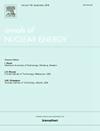HTR-PM平衡堆芯燃料及裂变产物特性分析计算模型的参数化研究
IF 1.9
3区 工程技术
Q1 NUCLEAR SCIENCE & TECHNOLOGY
引用次数: 0
摘要
鹅卵石床高温气冷堆(PB-HTGRs)中 TRISO 涂层颗粒的裂变产物(FPs)释放是一个重要的安全问题,受各种输入参数的影响。本研究利用 FIRCS 计算框架,研究了中子截面、网格分辨率和示踪卵石分布对燃料行为、放射性核素库存和高温堆-气冷堆平衡堆芯中释放率的影响。还提出了一种初步的多区域策略,以解决多普勒拓宽截面的堆芯内温度变化问题。结果表明,FPs 浓度和释放率(CRR)通常随着横截面温度的升高而降低。多区域方法产生的 CRR 值与高截面温度下的 CRR 值相似。此外,随着横截面温度的升高,平均燃料的累积燃耗和颗粒失效率(PFF)也会降低,而多区域方法产生的平均燃料燃耗最高。与依赖燃耗的横截面相比,寿命开始(BOL)横截面明显低估了 235U 的耗竭(低估了 2.21 倍),并高估了放电燃耗(高估了 20%)。较粗的网格过高预测了FPs的释放率,但提高了计算效率,突出了一种权衡。同样,示踪剂卵石的分布对释放率的变化也有显著影响,但网格分辨率和示踪剂分布对排放燃料锕系元素浓度和燃料行为的敏感性都很小。这项综合分析凸显了选择适当的截面库、网格分辨率、拟议的多区域策略和示踪卵石分布对于准确的 PB-HTGR 建模的重要性。研究结果为放射性核素行为和燃料性能提供了宝贵的见解,有助于开发更安全、更优化的 PB-HTGR 设计。本文章由计算机程序翻译,如有差异,请以英文原文为准。
Parametric study of the computational model on fuel and fission products characteristics analysis of HTR-PM equilibrium core
Fission products (FPs) release from TRISO-coated particles in Pebble Bed High-Temperature Gas-Cooled reactors (PB-HTGRs) is a critical safety concern, influenced by various input parameters. This study examines the impact of neutron cross-sections, grid resolution, and tracer pebble distribution on fuel behavior, radionuclide inventory, and release rates in the HTR-PM equilibrium core using FIRCS computational framework. A preliminary multi-region strategy has also been proposed to address in-core temperature variations for doppler broadened cross-sections. The results show that FPs concentration and release rates (CRR) generally decrease with increasing cross-section temperatures. The multi-region approach produced CRR values similar to those at high cross-section temperatures. Additionally, cumulative burnup and particle failure fraction (PFF) for average fuel decrease with increasing cross-section temperatures, and the multi-region approaches yield the highest average fuel burnup. Beginning-of-life (BOL) cross-sections significantly underestimate 235U depletion (by a factor of 2.21) and overestimate discharge burnup (by ∼20 %) compared to burnup-dependent cross-sections. Coarser grids over predict FPs release rates but improve computational efficiency, highlighting a trade-off. Similarly, tracer pebble distribution has a significant effect on release rate variability, but both grid resolution and tracer distribution show minimal sensitivity to discharged fuel actinide concentrations and fuel behavior. This comprehensive analysis highlights the importance of selecting appropriate cross-section libraries, grid resolutions, the proposed multi-region strategy, and tracer pebble distributions for accurate PB–HTGR modeling. The findings provide valuable insights into radionuclide behavior and fuel performance, supporting the development of safer and more optimized PB-HTGR designs.
求助全文
通过发布文献求助,成功后即可免费获取论文全文。
去求助
来源期刊

Annals of Nuclear Energy
工程技术-核科学技术
CiteScore
4.30
自引率
21.10%
发文量
632
审稿时长
7.3 months
期刊介绍:
Annals of Nuclear Energy provides an international medium for the communication of original research, ideas and developments in all areas of the field of nuclear energy science and technology. Its scope embraces nuclear fuel reserves, fuel cycles and cost, materials, processing, system and component technology (fission only), design and optimization, direct conversion of nuclear energy sources, environmental control, reactor physics, heat transfer and fluid dynamics, structural analysis, fuel management, future developments, nuclear fuel and safety, nuclear aerosol, neutron physics, computer technology (both software and hardware), risk assessment, radioactive waste disposal and reactor thermal hydraulics. Papers submitted to Annals need to demonstrate a clear link to nuclear power generation/nuclear engineering. Papers which deal with pure nuclear physics, pure health physics, imaging, or attenuation and shielding properties of concretes and various geological materials are not within the scope of the journal. Also, papers that deal with policy or economics are not within the scope of the journal.
 求助内容:
求助内容: 应助结果提醒方式:
应助结果提醒方式:


